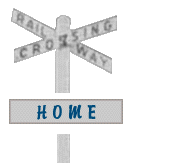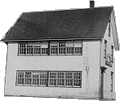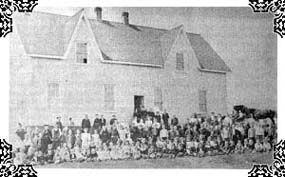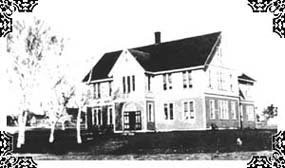









In 1834, Prince Edward Island had a very young population, with half of its 32,000 residents under the age of sixteen. With so many young minds in the colony, the government decided that it should make a more concerted effort to mold them. By1839, it had taken the first step towards establishing an Island-wide educational system, setting aside 1000 pounds sterling to support a series of district schools.
 However, the
history of schooling on Prince Edward Island certainly
does not begin in 1839. Evidence shows that, prior to
1794, there was a small log schoolhouse in Princetown
Royalty, the site of present day Malpeque (map).
Records from that year show that this rustic classroom
was deemed inadequate and that the community embarked on
the construction of a new school. The lieutenant governor
of the time, Edmund Fanning, was a frequent summer
visitor to the Malpeque area, and kept careful track of
these local efforts to promote education. Because of
Fanning's interest, the school-- finished in 1794--
However, the
history of schooling on Prince Edward Island certainly
does not begin in 1839. Evidence shows that, prior to
1794, there was a small log schoolhouse in Princetown
Royalty, the site of present day Malpeque (map).
Records from that year show that this rustic classroom
was deemed inadequate and that the community embarked on
the construction of a new school. The lieutenant governor
of the time, Edmund Fanning, was a frequent summer
visitor to the Malpeque area, and kept careful track of
these local efforts to promote education. Because of
Fanning's interest, the school-- finished in 1794--  was named in his
honor. Not only was the Fanning school prized by local
families, but 1815 newspaper reports also detail how
children from as far away as Charlottetown were sent to
attend its classes. By 1830, the first education bills
began to be heard in the Island legislature. Schools were
officially established at Charlottetown, Georgetown and
Princetown, and the first formal school records began to
be tabulated. Despite these efforts, the educational
system was hardly what one might describe as centralized,
with the government only able to list of twelve of the
many schools in operation at the time.
was named in his
honor. Not only was the Fanning school prized by local
families, but 1815 newspaper reports also detail how
children from as far away as Charlottetown were sent to
attend its classes. By 1830, the first education bills
began to be heard in the Island legislature. Schools were
officially established at Charlottetown, Georgetown and
Princetown, and the first formal school records began to
be tabulated. Despite these efforts, the educational
system was hardly what one might describe as centralized,
with the government only able to list of twelve of the
many schools in operation at the time.
During the 1840s, small schoolhouses began to spring up in Kensington and outlying districts. For the most part, the schools were one or two room structures, where a single teacher provided instruction to every grade. Basic subjects-- the 3 'R's-- were the emphasis of the curriculum, and teachers taught their pupils literacy through recitation and penmanship exercises. In 1876, officials tried to ensure that children across the Island were receiving the same level of education by adopting uniform textbooks. Another way in which the Department of Education kept an eye to school standards was through school fairs, where local children prepared speeches or compositions and the winners were sent to an Island-wide competition held in Charlottetown.
Even so,
enforcing educational standards was a bit of a logistical
impossibility on the Island. There were hundreds of
schools spread across the countryside and the running of
these buildings was very much at the discretion of the
local community, who often had to donate land for the
school and hire their own teacher. Well into the
twentieth century, the first public health nurse on
P.E.I.-- Mona Wilson-- wrote about her difficulties even
finding some schools. She recalls how she would have to
drive to the highest point in the surrounding countryside
and then look for the tell-tale smoke from the
pot-bellied stove.

Records indicate that there was no school in Kensington until 1847. During that year, a school house was finally built at the juncture of the Irishtown and Margate roads, close to where the five roads meet in Kensington. But this first school in Kensington started-- quite literally-- on shaky ground. There was a pond located immediately next to the building, and the foundation was built upon very swampy turf. If schoolchildren tend to get a sinking feeling when they have to go to school, this was doubly the case for Kensington's first students. Oftentimes, a plank had to be laid between road and doorway like a drawbridge so that children could traverse the marshy terrain. In fact, one student even remembered how, one day at recess, he used a raft to ferry himself to the other side. The bog did not go unnoticed for long. In the school inspector's report of March 27, 1848, he noted that-- while the reading skills were "superior to what is found in most schools"-- the school itself was located in "an unhealthy spot." Aside from the topography, local schools faced other challenges. There was often a wide variance between the number of children registered and the number in attendance, especially during the planting and harvest seasons. When the choice came down to education or the farm, the latter won out in most cases.
 To alleviate the
"unhealthy ground," a new two storey school was
raised in Kensington in 1880, located on the
appropriately named School Street in the centre of town.
After it outran its usefulness as a school, this building
was divided in two, with one half staying on the
foundation and the other moving to become a dwelling for
the Watson family.
To alleviate the
"unhealthy ground," a new two storey school was
raised in Kensington in 1880, located on the
appropriately named School Street in the centre of town.
After it outran its usefulness as a school, this building
was divided in two, with one half staying on the
foundation and the other moving to become a dwelling for
the Watson family.
But the sometimes adverse conditions in the schools obviously had no effect on the quality of students they turned out. The graduating class of 1896 included several men who went on to achieve places of distinction in local and provincial life. This single class included Waldin Darrach, a future mayor; Dr. John Mc Neil; James Pendergast, who became a member of the P.E.I. sports hall of fame; and Dr. W. J. P. MacMillan, elected premier of the province in 1933. In 1946, this class held a fifty year reunion to honor their teacher James Landrigan, and the guest list could have served as a 'who's who' for Kensington during the first half of the century.
 In 1903, the third
Kensington school was built, almost directly adjacent to
the 1880 school. This structure was originally a four
room structure, and over the years, four more rooms were
added so that the building could accommodate grades one
to ten. This building remained a high school until a new
facility was built in 1955; it then became the town's
elementary and served in this capacity until the 1960's.
Used for more than sixty years, the 1903 school had
considerably more staying power than its 1840's
predecessor. Kensington is proud of its long school
history, where-- if one school might have sank slightly--
the high educational standards never did.
In 1903, the third
Kensington school was built, almost directly adjacent to
the 1880 school. This structure was originally a four
room structure, and over the years, four more rooms were
added so that the building could accommodate grades one
to ten. This building remained a high school until a new
facility was built in 1955; it then became the town's
elementary and served in this capacity until the 1960's.
Used for more than sixty years, the 1903 school had
considerably more staying power than its 1840's
predecessor. Kensington is proud of its long school
history, where-- if one school might have sank slightly--
the high educational standards never did.
